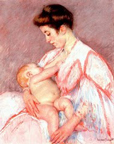Welcoming All Families Series: Welcoming People of Size In Your Birth Classes
By: Pam Vireday | 0 Comments
Continuing along in our occasional series on 'Welcoming All Families' to our childbirth classes, this two part guest post is written by Pam Vireday, creator of the Well-Rounded Mama blog. Are your childbirth classes friendly to people of size? What special accommodations and resources do larger-sized parents-to-be need if any? In today's post, Pam discusses a check list of items that you might consider when teaching childbirth classes and on Thursday, Pam shares how to promote in your classes optimum outcomes at the births of these parents.- Sharon Muza, S&S Community Manager
______________________

MatthiasKabel GFDL
www.gnu.org/copyleft/fdl.html
Wikimedia Commons
Although the exact numbers vary according to the source used, it is no secret that many people of childbearing age are 'overweight' or 'obese'* by government standards. This means that, sooner or later, most doulas, childbirth educators and health care providers will have people of size as clients or patients.
Many birth professionals are unsure of how to address the unique needs of this group. At a time when the media messages around obesity and pregnancy are almost uniformly negative and scare-mongering, it is important that birth professionals create a place for people of size to discuss their unique concerns without judgment.
Terminology*
Research shows that many larger people find the terms 'obese' and 'overweight' stigmatizing. Although size-acceptance activists prefer the word 'fat,' some people cannot hear this term neutrally, and euphemisms like 'fluffy' can feel patronizing.
Birth professionals are encouraged to notice and adopt the terminology used by clients for themselves. Until then, use more neutral terms like 'plus-sized' or 'people of size.' (Further discussion of the relative merits of various terms can be found here.)
Create a Safe Space
Most larger people have been negatively judged by others for their weight, and the disapproval is never stronger than when they consider pregnancy. People of size need a non-judgmental space where they can feel free to discuss their concerns for pregnancy without being shamed, lectured to, or made to feel like 'bad parents.'
Your job as a birth professional is to create this safe place. Examine your own biases about weight, eating, and health. Question your assumptions and engage with each person as an individual. Utilize reflective listening, assist them in researching special issues, and neutrally explore proactive behaviors that might help address their concerns.
Make Sure Facilities Are Size-Friendly
Ask yourself - are your facilities friendly to larger bodies? Do you have armless chairs? Seating that is easy to get up from? Restrooms that accommodate larger people? Comfortable facilities set the tone for a space that is welcoming to all sizes.
Remember that getting up and down from the floor can be difficult for many people in pregnancy, not just heavier people. Have a few low stools around that people can use to help boost themselves up. Also be sure your birth balls are appropriate for heavier people; a little higher and a little more heavy-duty balls can be helpful.
Address Special Equipment Needs
The correct blood pressure cuff size is vital for larger people. A too-small cuff can artificially inflate blood pressure readings and result in unnecessary intervention.
According to guidelines from the American Heart Association, people with upper arm circumferences above about 13.4 inches (34 cm) need a 'large adult' cuff, while those with a circumference above about 17.3 inches (44 cm) need a 'thigh' cuff. If in doubt, measure the client's arm and cross-check it against the reference range printed on the BP cuff.
Some care providers resist using larger cuffs, so people or their support people may need to be quite assertive about utilizing the correct cuff size.
Discuss Breastfeeding When Well-Endowed
Some high-BMI people are quite well-endowed. This can present special challenges in breastfeeding, yet many pelople receive no information on how to meet these challenges. Cover a variety of nursing positions and techniques, including the football hold, which may be more useful for well-endowed nursing people.
Have Additional Resources Available for People of Size
A consistent problem for people of size is the difficulty in finding resources for their specific needs. For example, finding maternity clothes or a nursing bra in a larger size can be a major problem. Many people appreciate having a list of companies that specialize in plus-size maternity products.
Address Potential Risks and Complications
While the possibility of complications must be acknowledged, remind people that having a risk factor for a complication does not inevitably mean developing that complication. An individual's outcome cannot be predicted by risk factors alone. Treat people of size like any other pregnant person by expecting normal outcomes much as possible.
Share websites that examine weight-related research with a neutral, critical eye, which acknowledge that complications are possible and promote proactive prevention, but which also point out that larger people can and do have normal, healthy pregnancies and births.
Find Positive Images and Stories of People of Size

photo courtesy of Diaz Family
Media images of heavy people in our society are highly stigmatizing. Most pictures of fat people are headless (dehumanizing them), unflattering (focusing on bellies or behinds in tight clothes), or reinforce stereotypical behavior (eating junk food or being sedentary).
Media discussions of pregnancy and obesity focus only on the risks for complications, tell apocryphal stories of worst possible outcomes as if they are commonplace, or compare fat pregnancy to child abuse.
Books that focus on obesity and pregnancy pay lip service to being size-friendly, but contain a preponderance of negative stories, highly-interventive births, and scare tactics about complications. As one doula reviewer on Amazon wrote, 'More time was spent telling me how much more likely I am to have a cesarean than to tell me how I can best avoid one.'
It's very important to counteract these negative messages and images with positive ones. Direct your client to websites which have plenty of positive images of people of size pregnant, giving birth, and breastfeeding (see list below). Connect them with a community of like-minded people if they are interested.
Respect Patient Autonomy
Different people will look at the same information with differing values and make varying choices. The same is true for people of size. Some will respond to information about obesity-related risks by choosing a more-interventive childbirth model, and some will respond by choosing a less-interventive model. Neither choice is right or wrong. Respect each person's right to choose for themselves.
'All in all I think I just want to be treated the same as anyone else. Give me the information, not opinions, not value judgments. Let me decide what to do with it. Give me all the information, not what you perceive or decide I need. Treat me as thinking adult. Treat me with respect. Don't belittle me, and do not treat me with kid gloves either.' Lexi Diaz, plus-sized mother of four.
Do you do anything different when people of size attend your classes? Do you feel like your classes already accomodate any special needs they might bring? Do your visual aids and resource lists include pictures of people of size and resources designed for their needs? Do you feel that any person of size attending your class feels welcome or alone? What have been your experiences with larger sized pregnant people taking your classes or being your client or patient. Let us know your experiences in the comments section and share additional resources if you would like. Read on Thursday, when Pam shares how CBEs can help women have optimum outcomes at their births.- SM
Plus-Sized Resources
Plus-Sized Pregnancy Information
Finding Maternity Clothing in Plus Sizes
Positive Images of Plus-Sized Pregnant Women
*Do not use any of these photos without asking permission first
Birth Stories of Plus-Sized Women
About Pam Vireday

Painting by Mary
Cassatt, 1844-
1926. (public
domain) Image from
Wikimedia
Commons.
Pamela Vireday is a childbirth educator, writer, woman of size, and mother to four children. She has been collecting the stories of women of size and writing about childbirth research for 17 years. She writes at www.wellroundedmama.blogspot.com and www.plus-size-pregnancy.org.
Published: November 05, 2012
Tags
Postpartum depressionPregnancyBreastfeedingChildbirth educationMaternal Infant CareEvidence-Based Care For Women of SizeMaternal ObesityPregnancy In Women Of SizeSeries: Welcoming All FamiliesObesitybetter birth outcomesPamela Viredaypositive parenting teamWelcoming All Families